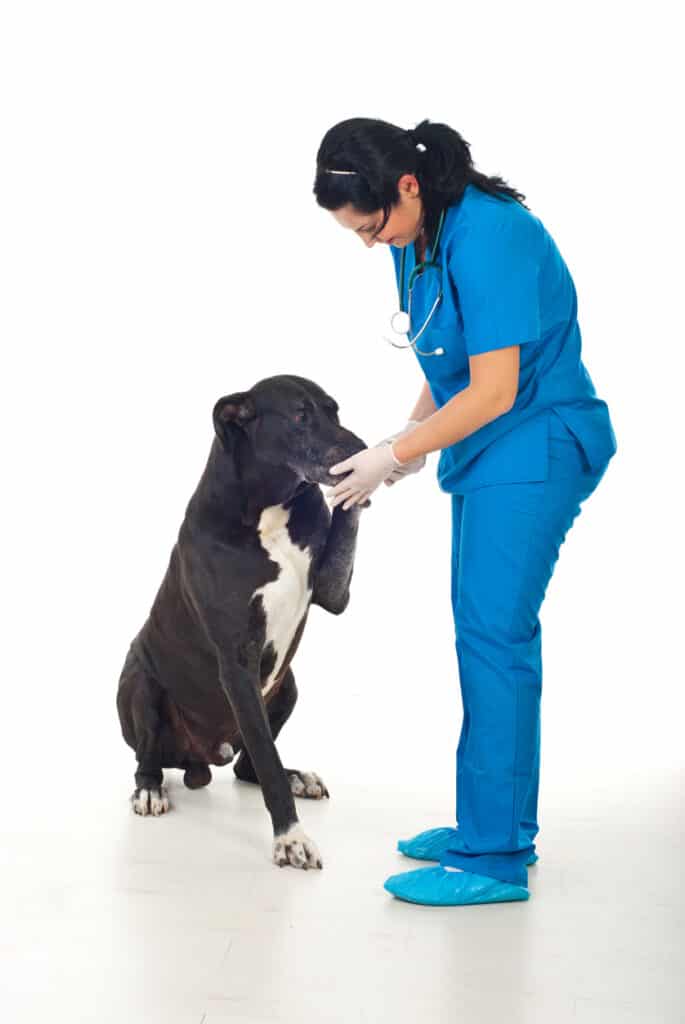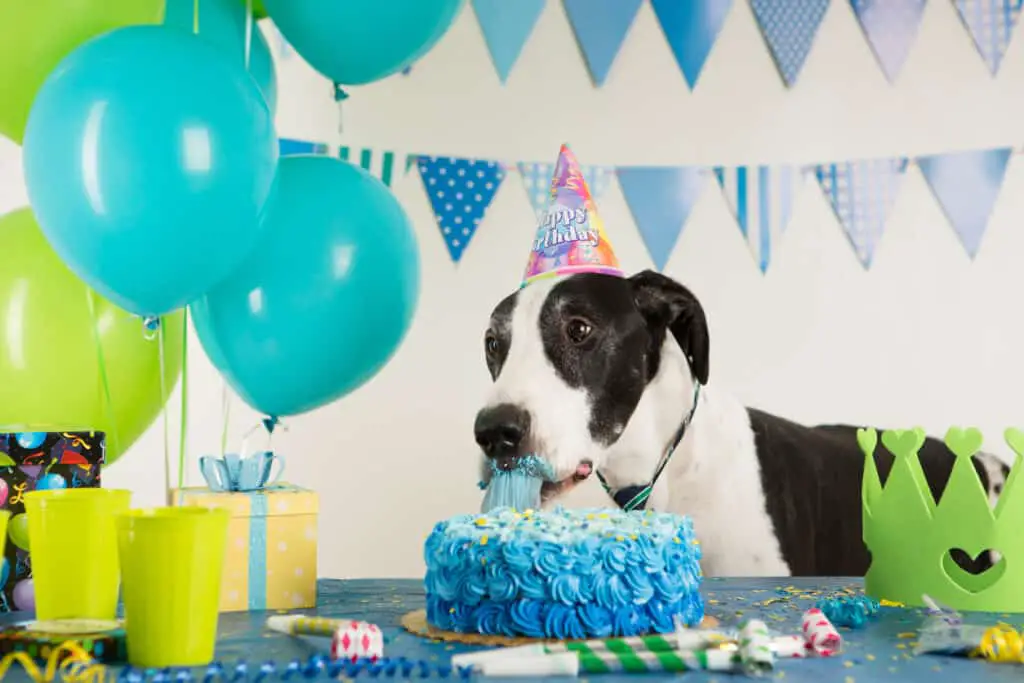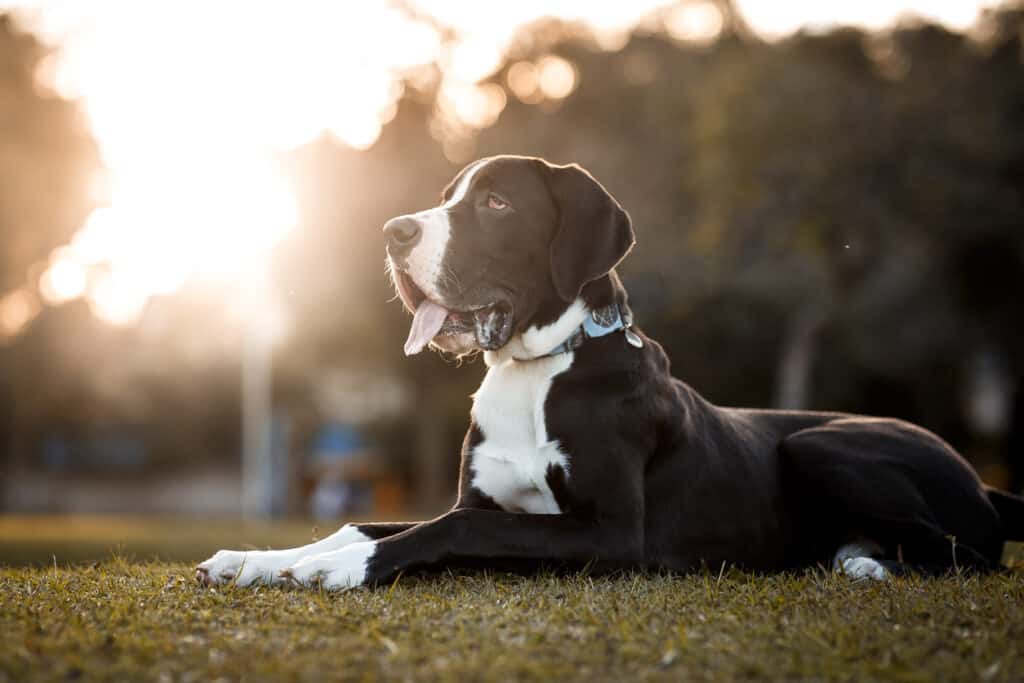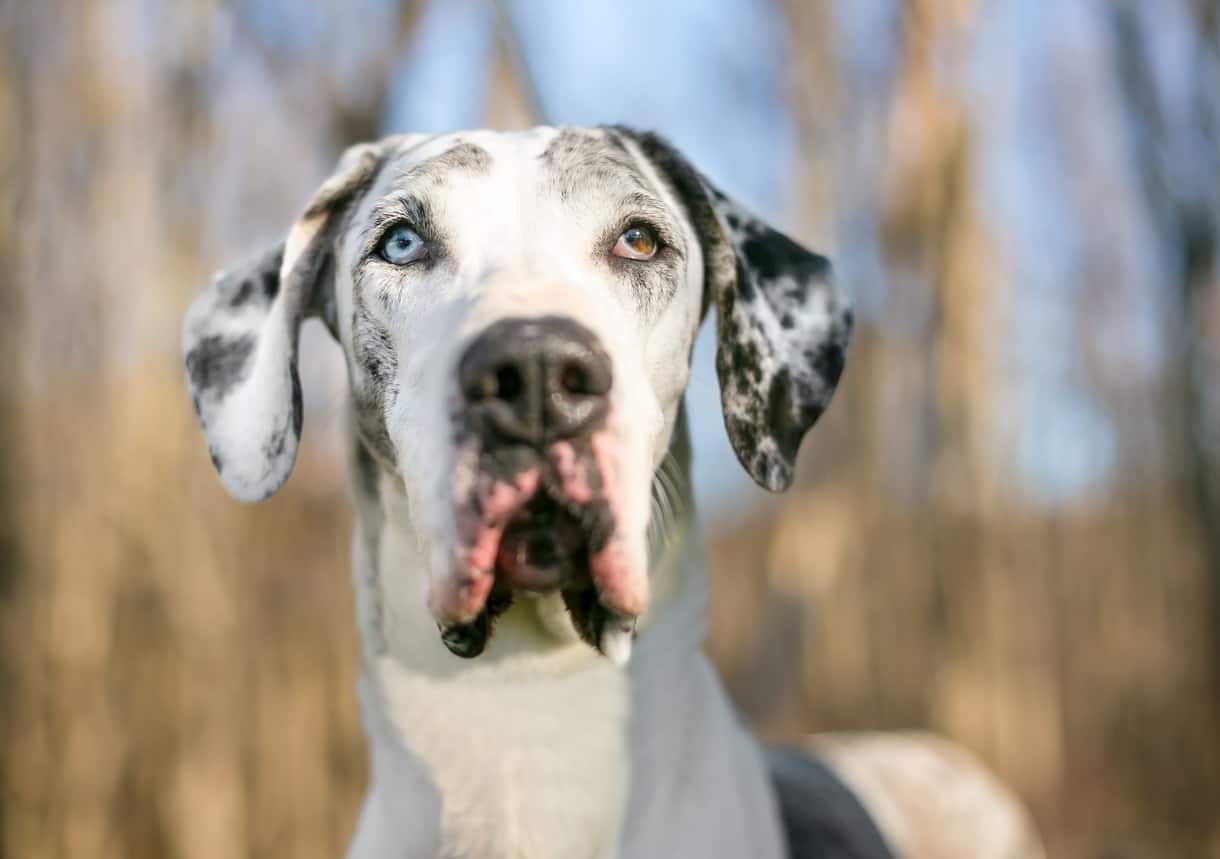Great Danes are very popular family pets due to their giant size paired with their affectionate, loving nature. While their size is often a main factor in reasons why people love Great Danes, their size also influences just about every aspect of their life. This includes decisions that may initially seem straightforward, such as when to neuter a Great Dane.

For starters, whether you neuter a Great Dane or spay a Great Dane will depend on its sex. Most owners wait at least a year to spay and up to a year and a half if they decide to neuter.
Neutering is the procedure of removing the testicles of a male animal, while spaying is the procedure performing a hysterectomy (removing the uterus, fallopian tubes, and ovaries) on a female animal. Animals that are not neutered or spayed are referred to as “intact” while animals that do undergo the surgical procedure to prevent them from reproducing are referred to as “altered.”
There are many factors for owners to consider before deciding one way or the other. One of the primary ones will be whether the Great Dane will one day be bred to continue its bloodline. If you as an owner intend to become a Great Dane breeder, then altering your Great Dane will not be an option. In addition to leaving their Great Dane intact, owners who wish to become Great Dane breeders should take care to develop a robust knowledge (if they have not done so already) on the history of the breed and responsible breeding practices.

If you do not intend to breed your Great Dane, altering your animal is a simple way to invest in their long-term health. In fact, studies show that both neutered and spayed Great Danes live longer than their intact counterparts! This is especially important for Great Dane owners to note because of the already-short lifespan of these giant dogs. On average Great Danes will live for seven to ten years, meaning that even a slight increase in that short period of time will give you more time with your beloved family pet.
The health benefits of altering a Great Dane are many, but they do differ slightly based on the sex of your animal. For example, neutering male Great Danes often has the effect of reducing their territorial inclinations such as aggression and marking. Marking occurs when a male is compelled to urinate, thereby “marking” his territory. Unfortunately, males often to do not discriminate between marking indoors and out and may find it a challenge to do so even when properly trained due to the instinct to claim their territory. Great Danes, like all dogs, have incredibly powerful noses, and so by urinating a male Great Dane is announcing himself to every other dog that may come within his territory.
Intact male Great Danes will likely exhibit greater aggression and inclinations to roam than their altered counterparts. While known for being a docile breed, intact males will have a stronger inclination to have more aggressive reactions to situations that are startling, frightening, or annoying. While many of these urges can be mitigated by proper, thorough, and regular socialization of your Great Dane, neutering is a virtually fool-proof option to reduce the aggressive response in your male.

Additionally, intact male Great Danes will feel compelled to roam. Roaming refers to the instinct to actively seek out a mate and this urge is activated when the male senses that a female is in heat. This can happen on a walk, or even if an intact female is walked past your yard by her owner. While that may sound harmless enough, male Great Danes can become excellent escape artists from even well-secured yards, which at the very least causes worry and at its worst causes accidents involving cars or other intact males, or unwanted litters of puppies.
Spaying female Great Danes is considered a proactive step toward reducing their risk for uterine infections and cancer. Intact females will also experience the urge to roam, meaning that owners who do not spay their female Great Dane will have to be especially vigilant about ensuring their Great Dane does not escape for a rendezvous with an intact male –otherwise, the result could be unwanted puppies in your home!
There are some developmental particularities to bear in mind should you decide to alter your Great Dane puppy. While indisputably a great choice for your puppy’s long-term health, Great Dane puppies have special needs pertaining to their growth. The reason for this is that a Great Dane puppy is likely to gain somewhere around 100 pounds in its first year of life, and its growth phase is not complete until around three years of age. Because of this extended growing period, owners seeking to alter their Great Danes should be aware that the standard practice of neutering or spaying around six or seven months should not apply to their Great Dane. Instead, male Great Danes should be neutered around one year of age, while females should be allowed to undergo one heat cycle before being spayed.
Typically, females are spayed prior to experiencing a heat cycle in order to reduce the risk of mammary cancer, however, because of the prolonged growth period Great Danes experience, it is typically recommended that female Great Danes be permitted to go into heat once prior to scheduling their surgery to be altered. This gives her hormones more time to positively influence her growth for as long as possible before the appropriate window for spaying occurs.
Because neutering or spaying your Great Dane is a surgical process, your veterinarian may recommend scheduling a gastropexy for during the same operation as the alteration. A gastropexy is a surgical procedure performed to pin the Great Dane’s stomach in order to prevent it from twisting if it develops bloat. The reason owners are encouraged to schedule both procedures during the same operation is to avoid placing the animal under anesthesia multiple times, and because a gastropexy can be a proactive way to address the Great Dane’s risk of developing bloat.
The best way to determine whether a double procedure is right for you is to consult with your veterinarian about your Great Dane. It’s worth mentioning that one or both of these procedures will be expensive—in general, you’re looking at around $300 to neuter a Great Dane, and more than that to spay. Including a gastropexy will increase the cost to somewhere in the neighborhood of $1000, however, these procedures can be seen as an investment into the long-term health of your furry family member. The final decision should always be taken in consultation with your Great Dane’s veterinarian.
If you decide to neuter or spay your Great Dane, you will need to provide attentive care for them prior to and after the surgery. While male Great Danes can typically be neutered after their first birthday, the Great Dane Club of America recommends waiting until three months after a female’s first heat cycle to schedule a spay. Additionally, they stress the importance of working with a veterinarian who has experience with giant breeds, as these animals have certain needs when it comes to what types of anesthesia are appropriate, as well as other factors.
All dogs are highly susceptible to hypothermia after undergoing surgery, and the Great Dane is no exception. Owners will need to be prepared to provide the appropriate equipment such as blankets, heating pads, and careful monitoring to ensure that their Great Dane is properly recovering.
It will take as much as a full day for the anesthesia to wear off, so after your Great Dane puppy is brought home, you will want to keep them as separate from the rest of the household as possible. Doing so will create a calm and quiet environment for them to recover.
After undergoing the surgery, the Great Dane will need to wear an Elizabethan collar (colloquially known as a “cone of shame”) for up to two weeks after the procedure. The purpose of the collar is to prevent them from licking or ripping at the stiches, which will cause itching as they heal. During this period of healing, your puppy will be unable to engage in play and physical activities as normal and should be closely supervised. It should also be kept away from other animals or young children in the household who may seek to play with it.
Depending on the type of stitches used during the procedure, a follow-up may be necessary with your vet so that they can remove the remaining stitches. Your veterinarian will ensure that you are aware of all the proper steps involved in bringing your Great Dane puppy in for the procedure through guiding the puppy through its recovery.
While most veterinarians are just a phone call away, it can help to feel generally prepared for what to watch out for as you care for your Great Dane puppy post-surgery. As a general rule of thumb, if the incision becomes re-opened, it is as if a wound has become re-opened and your puppy will need to be taken back to the vet immediately. Additionally, the incision area should be carefully monitored for liquid or an unhealthy odor. Some swelling is to be expected, and with careful monitoring you will be able to tell if swelling becomes abnormal.
It is not recommended to bathe your Great Dane puppy after surgery in order to give the wound time to heal properly.
So, the answer to the question of when to neuter a Great Dane is perhaps less important than the actual decision of should you neuter your Great Dane. In addition to the aforementioned reasons that describe the benefits of neutering or spaying your Great Dane, another reason for altering your Great Dane pertains directly to the Dane’s immense need for socialization.
It is well-documented that Great Danes need regular and thorough socialization throughout their lives, however, leaving your Dane intact, particularly if it’s a male, could render him an outcast at the dog park, or outright rejected from places such as doggy day care. This isn’t a moral judgement against the decision to leave an animal intact so much as a logistical decision: it is much more difficult to manage intact male dogs than neutered dogs. While females don’t face the same risk of ostracization by kennels and doggy day cares, they could still elicit some aggressive or territorial behavior from intact male dogs or male puppies on the verge of puberty at dog parks, much to the chagrin of their owners.
All in all, unless you intend on becoming a Great Dane breeder, neutering and spaying offers the best course of action for the long-term health of your Great Dane.

